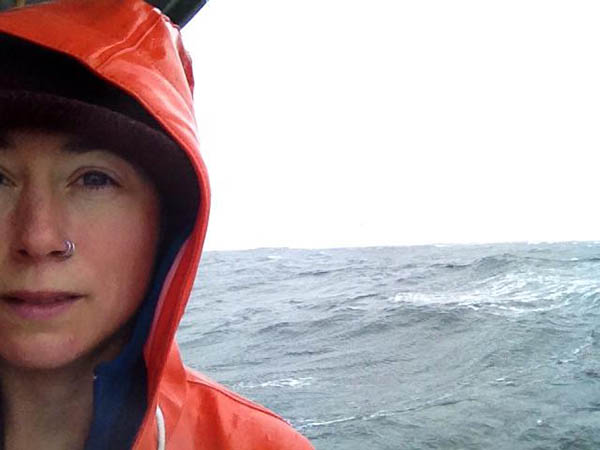I’ve yet to find anywhere in the world that gives me the same sense of peace as Sitka does. Just pulling into the harbor and stepping onto the dock, my body relaxes bone-marrow deep. And if I had to pick a single place where that slow down, breathe deep, let go effect is strongest, it would be Totem Park.
Strange to find peace on soil so scarred by grief. This dense Tongass rainforest spooning the sea is the site of the Tlingit/Russian 1804 Battle of Sitka. Formally known as Sitka National Historical Park, these 113-acres gained national monument status in 1910, in commemoration of that combat.
2010 marked Totem Park’s Centennial. A year’s worth of ceremonies are concluding with the raising of a new totem. Tommy Joseph, world-renowned carver and Southeast Alaska Indian Cultural Center Artist-in-Residence, was commissioned to do this project. A project he would typically give 5 – 6 months, completed in just over one.
An achievement like this takes serious teamwork. Tommy describes his policy on drafting volunteer as this: If you drop by the carving shed more than twice, “we’re gonna put a tool in your hand and put you to work.”
I considered that. Imagined the honor and responsibility of such a task. And I marveled at Tommy’s casually inclusive attitude, wondering: Would it truly be “okay” for a white person – like me – to participate in such sacred creation?
As a liberal arts graduate and former social worker, I know the weight of my invisible duffle bag of white privilege, luggage that accompanies me everywhere. I’m not one of those fishermen who believe treaty rights are a personal attack, and have walked away from dock conversations with those who do. I have no patience for white “shamans,” and feel uneasy with the appropriation of cultural traditions commodified as “cool.”
I tried to imagine what it would be like to shave away bits of cedar, to witness the story within that particular log revealing itself, a friend who exposes more of their true self as time and trust build. And I wondered, how would Tlingit carvers feel, working alongside hands that wore the same skin as those who chopped down totems, stole homeland and history, stole the very words from their ancestors’ mouths?
These are valid questions. But perhaps they’re more reflective of my own personal process. Sitkans are about getting the work done, and bringing a totem to life requires many workers.
Whenever a pole raising is scheduled, the Sitka Sentinel prints a call for volunteers, reminders that “we need hundreds of people to get this up.” While I’m hanging back uncertain, questioning my place, Tommy Joseph and other cultural healers are waving their arms in exasperated invitation. “C’mon, we can’t do this alone!”
Because – as Sitkans have taught me – if it takes a village to raise a child, it takes a town to raise a totem.
[Raven Radio has a great interview with Tommy and the volunteers, which you can hear/read here. Though the pole was scheduled to go up on April 9, it has been delayed by the potential government shutdown.]





Tele,
I love your description of Totem Park: “bone-marrow deep.” Indeed, this is a special totem pole.
This is a great post, and you raise so many important questions here. This is something I struggle with quite a bit, and I’m not sure there are any easy answers. I think one of the most important things — which you talk about in your your post — is that we continue asking these questions and that we continue the dialogue.
Thanks to you both for the kind words. Yes, they’re on-going questions, ones that I suspect will appear in Hooked again, and I agree about the dialogue. A tough process, but so rewarding.
I loved the way you tell a story, but more so since this post is about indigenous culture. Its great that you are taking time to share this to the world. If I had time to go around and travel as well, I might just see what stories our natives here have to tell.
Thanks very much, Aga — I’m delighted that we’re trading blog visits between Alaska and the Philippines! I’ll post Part 2 of the Totem Raising here in the next day, and will be looking forward to Part 2 of your short story, also.
Tele —
What a beautiful blog you have created. Thoughtful, deep — beautifully written. I have never been to Alaska — but you bring it to life. I appreciate the weight with which you consider all sides of an issue.
Thanks so much — I’m going to follow your blog.
Cathy
Thank you, Cathy, for the kind words. Just as you haven’t been to Alaska, She Writes has been taking me to all kinds of great blogs I wouldn’t have otherwise found. Definitely enjoying our new community… So good to join you out here!
Great story Tele! And that is such a special place, I love Sitka. I was once told there is an energy vortex there. Maybe that is why I always get those warm fuzzy feelings when I arrive. Or the calm I feel in that beautiful but eerie park. Or, who knows, maybe its the pies at the airport.
Yes! Sitka is all about the pie, isn’t it? Next time you stop through, try to visit the Backdoor Café, behind Old Harbor Books… Bernadette makes the best pies — the best baked deliciousness, period, but it’s that first cup of coffee and slice of pie that assures me I’m home.
What a lovely metaphor for life and living as a society! It’s a beautiful story and a beautiful place that you descrive, I hope to visit .
This is an amazing park and the art is awesome. Wonderful that a place that has seen violence can be reclaimed as a place of cultural healing. Wonderful that hands of many colors can create art and healing at the same time. None of which diminishes the weight of white privilege. There are no easy answers. It’s all about how we carry the questions. You carry them with beauty.